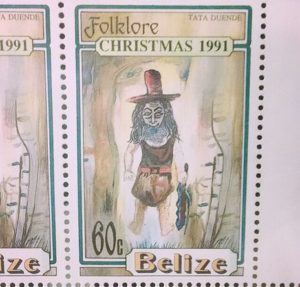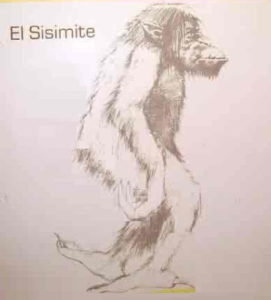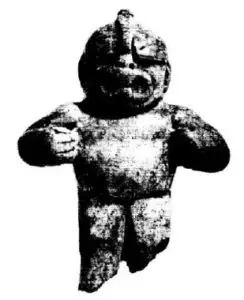Podcast: Play in new window | Download
Subscribe: Apple Podcasts | RSS
 Does Mexico have its own version of Bigfoot? The answer is “yes.” It’s called the Sisimite and he is only found in 3 Mexican states: Campeche, Chiapas and Quintana Roo. It has been spotted in the jungle-covered tropical areas of these states and is said to range all the way down the heavily forested Central American cordillera to Colombia where he has been nicknamed the Darien Monster. The Sisimite has also been called “The Olmec Ape” based on a figurine found at an Olmec archaeological site in the state of Campeche. The figurine dates back 2,000 years.
Does Mexico have its own version of Bigfoot? The answer is “yes.” It’s called the Sisimite and he is only found in 3 Mexican states: Campeche, Chiapas and Quintana Roo. It has been spotted in the jungle-covered tropical areas of these states and is said to range all the way down the heavily forested Central American cordillera to Colombia where he has been nicknamed the Darien Monster. The Sisimite has also been called “The Olmec Ape” based on a figurine found at an Olmec archaeological site in the state of Campeche. The figurine dates back 2,000 years.
So, what does this creature look like and what are its origins? The Sisimite has been described as a hairy ape-like creature, much larger than a human, with the face of a human. It has only 4 fingers and no thumbs, and in some cases it has been described as having backwards-facing feet. Sisimites walk upright, like humans. They let out high-pitched screams but have no language. They are generally regarded as being hostile to humans and have been accused of kidnapping people. Their apelike fur has been described as ranging from a chestnut color to pitch black. They have no protruding ears and their noses are flat. Cryptozoologists, those who study unknown or mythical animals, suspect that the Sisimite came across the Bering land bridge with humans – and its northern cousin, Bigfoot – some 40,000 years ago. Why it is confined to the dense jungles of southern Mexico, thousands of miles away from the closest Bigfoot sighting, is unknown. Perhaps the northern offshoots of this creature were killed off by early humans, or if this is something unrelated to Bigfoot, the habitat of the north and central parts of Mexico were not conducive to the survival of the Sisimite. Some believe that the creature is a surviving remnant of Gigantopithecus, a large prehistoric ape native to Asia that stood almost 9 feet tall and supposedly died out over 100,000 years ago.
 Briefly, we will get sidetracked here and mention that the Sisimite has a smaller cousin who lives in the same region. The creature’s little cousin is simply called the Duende by Spanish-Speakers and the Dwendi by the English-speaking people of the country of Belize, which is in the heart of the Sisimite’s territory. People who still speak one of the many Maya dialects refer to the Duende as Nukux Tat. The word Duende in Spanish literally means “elf” or “dwarf”. It is described as a much shorter hairy humanoid and is often seen or depicted wearing a sombrero or woven palm leaves on his head. This 3 to 4 foot tall creature is described as a trickster and is seen as more of a mythical creature possessing magical powers. Often he has been described carrying a stick or machete and can be clad in rags or animal skins. The Duende has been described as a creature perpetually engaged in mischief, he has alternatively been known to rescue lost people in the forest and kidnap them. He is also seen as being a protector of all the animals in the jungle. The Duende is used to scare children not to play in the forest alone as it is said he may kidnap kids and take them to his cave to hold them hostage. Farmers may blame the tricks of the Duende for bad crops. Many people who have studied the Sisimite have categorized the Duende as more of a mythological creature whereas his larger cousin could most likely be a real and yet undiscovered animal. The Duende is mentioned here because it also may be an embellished cryptid and has some of the same characteristics as have been ascribed to the Sisimite, notably, a body covered in a course fur and backwards-facing feet. The country of Belize issued a postage stamp as part of a folklore series that depicts the Duende.
Briefly, we will get sidetracked here and mention that the Sisimite has a smaller cousin who lives in the same region. The creature’s little cousin is simply called the Duende by Spanish-Speakers and the Dwendi by the English-speaking people of the country of Belize, which is in the heart of the Sisimite’s territory. People who still speak one of the many Maya dialects refer to the Duende as Nukux Tat. The word Duende in Spanish literally means “elf” or “dwarf”. It is described as a much shorter hairy humanoid and is often seen or depicted wearing a sombrero or woven palm leaves on his head. This 3 to 4 foot tall creature is described as a trickster and is seen as more of a mythical creature possessing magical powers. Often he has been described carrying a stick or machete and can be clad in rags or animal skins. The Duende has been described as a creature perpetually engaged in mischief, he has alternatively been known to rescue lost people in the forest and kidnap them. He is also seen as being a protector of all the animals in the jungle. The Duende is used to scare children not to play in the forest alone as it is said he may kidnap kids and take them to his cave to hold them hostage. Farmers may blame the tricks of the Duende for bad crops. Many people who have studied the Sisimite have categorized the Duende as more of a mythological creature whereas his larger cousin could most likely be a real and yet undiscovered animal. The Duende is mentioned here because it also may be an embellished cryptid and has some of the same characteristics as have been ascribed to the Sisimite, notably, a body covered in a course fur and backwards-facing feet. The country of Belize issued a postage stamp as part of a folklore series that depicts the Duende.
 But, back to our larger cryptid, the Sisimite. This creature has long been part of the animal make-up of the forest according to the Maya who still live in the creature’s territory. The traditional Maya beliefs, going back to ancient times, divide the world of spiritual beings into three categories. There are the main powerful deities that lord over the universe, the gods of the sky, the earth, the water, etc. Then there are the local spirits that may inhabit certain areas of the forest, or a geographical feature such as a mountain or a landmark tree. The last group of spiritual beings include certain animals of the forest that are connected to the gods or local spirits. The jaguar has special powers because it is connected to the higher spirits, for example. The Sisimite is considered to be another animal that is “plugged in” to the spirit world while being a real living breathing animal of the forest.
But, back to our larger cryptid, the Sisimite. This creature has long been part of the animal make-up of the forest according to the Maya who still live in the creature’s territory. The traditional Maya beliefs, going back to ancient times, divide the world of spiritual beings into three categories. There are the main powerful deities that lord over the universe, the gods of the sky, the earth, the water, etc. Then there are the local spirits that may inhabit certain areas of the forest, or a geographical feature such as a mountain or a landmark tree. The last group of spiritual beings include certain animals of the forest that are connected to the gods or local spirits. The jaguar has special powers because it is connected to the higher spirits, for example. The Sisimite is considered to be another animal that is “plugged in” to the spirit world while being a real living breathing animal of the forest.
Although native to the world of the Maya, the name Sisimite comes from a Nahuatl – Aztec – word tzitzimitl which loosely means “demon” or “supernatural creature.” While known to the Maya for centuries, the first outside report of the Sisismite came from a group of Spanish gold prospectors in the 18th Century. On an expedition in what is now Honduras, a member of this group supposedly shot and killed one of the creatures that was raiding the mining camp.
The Sisimite made its debut in the English-speaking world through the writings and reports of a man named Edward Jonathan Hoyt, who was nicknamed “Buckskin Joe.” Hoyt was born in Lower Canada – modern Quebec – in 1840. He headed south in 1861 to take part in the American Civil War, fighting on the Union side. Between the end of the war and a trip to tropical Mexico and Central America in 1898, Buckskin Joe traveled with circuses across America and was an aerialist and acrobat in addition to playing 16 musical instruments. On that 1898 gold prospecting adventure he would encounter our horrible hominid, shooting a Sisismite that crawled onto his bunk while he was sleeping. The account made the papers back home.
 The Sisimite appeared again in a 1961 compendium compiled by author Ivan T. Sanderson titled, Abominable Snowmen: Legend Come to Life. In the book the author compiled stories of the Central American Bigfoot, mostly concentrating on British Honduras, the former name of what we now call Belize. The Abominable Snowmen book prompted Bigfoot researcher Mark Sanborne to track the creature in 1992, and he, too, compiled stories from tropical Mexico, Belize and Guatemala. Both works are full of eyewitness accounts of the creature.
The Sisimite appeared again in a 1961 compendium compiled by author Ivan T. Sanderson titled, Abominable Snowmen: Legend Come to Life. In the book the author compiled stories of the Central American Bigfoot, mostly concentrating on British Honduras, the former name of what we now call Belize. The Abominable Snowmen book prompted Bigfoot researcher Mark Sanborne to track the creature in 1992, and he, too, compiled stories from tropical Mexico, Belize and Guatemala. Both works are full of eyewitness accounts of the creature.
So, then, is the Sisimite real or imaginary? Is it like the Giant Panda and the Mountain Gorilla, a real animal that managed to evade human investigation until modern times? Or is it just a myth created to scare children? We have many stories and eyewitness accounts and in spite of people claiming to have shot the creature, we have no physical evidence of the Sisimite. Like Bigfoot, no one has yet produced a body or captured one alive.
